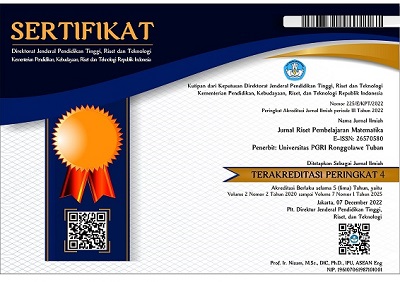PENGUJIAN VALIDITAS DAN RELIABILITAS KONSTRUK INSTRUMEN KREATIVITAS MAHASISWA PADA MODEL COMPUTER ASSISTED INSTRUCTION (CAI)
DOI:
https://doi.org/10.55719/jrpm.v1i1.61Keywords:
CAI, creativity, convirmatory factor analysisAbstract
This study aims to examine the validity and reliability of the construct of creativity instruments, determine the contribution of aspects and indicators of creativity in measuring the creativity variable and confirm the hypothesized model that is the suitability of the model with data using the Second order confirmatory factor analysis (2nd Order CFA). The population in this study were second semester students of mathematics education at the University of PGRI Semarang with a total sample of 105 students. Samples were taken using non-probability sampling techniques. Data analysis was performed using the Linear Structural Model (LISREL) version 8.8. The results of the analysis indicate that aspects of fluency, flexibility, originality and elaboration, are able to reflect creativity variables positively, validly and significantly which are supported by behavioral indicators of each aspect. The theoretical model of the creativity variable is fit with empirical data. Valid and significant and reliable aspects of creativity to measure student creativity. The most dominant aspect that reflects creativity is the originality aspect and the weakest aspect is flexibility.
Downloads
References
Alimuddin, (2009). Menumbuhkembangkan Kemampuan Berpikir Kreatif Siswa Melalui Tugas-tugas Pemecahan Masalah. Prosiding Seminar Nasional Penelitian, Pendidikan dan Penerapan MIPA, Fakultas MIPA, Universitas Negeri Yogyakarta
Ghozali I., & Fuad. (2012). Structural equation modeling, teori,konsep dan aplikasi dengan program LISREL 8,8. Semarang: Universitas Diponegoro.
Hair, J.F., Black, W.J., Babin, B.J., & Anderson, R.E. (2010). Multivariate data analysis. Englewood Cliff, NJ: Prentice Hall.
Hendryadi & Suryani. (2014). Structural Ecuation Modeling dengan Lisrel 8.80 Pedoman untuk Pemula. Yogyakarta: Kaukaba Dipantara.
Kenedi. (2017). Pengembangan kreativitas Siswa dalam Proses Pembelajaran di Kelas II SMP Negeri 3 Rokan IV Koto. Jurnal Ilmu Pendidikan Sosial, Sains, dan Humaniora. Vol. 3, No. 2, Juni 2017 : 329 – 347
Mioduser, D and etc. 2000. The learning value of computer-based instruction of early reading skills. Journal of Computer Assisted Learning, 16, 54-63
Richardo. R, Mardiyana, Saputro. DRS. (2014). Tingkat Kreativitas Siswa Dalam Memecahkan Masalah Matematika Divergen Ditinjau Dari Gaya Belajar SISWA (Studi Pada Siswa Kelas IX MTS Negeri Plupuh Kabupaten Sragen Semester Gasal Tahun Pelajaran 2013/ 2014). Jurnal Elektronik Pembelajaran Matematika,. Vol 2, No. 2 : hal 141 – 151.
Surjono, H. (1995). Pengembangan Computer Assisted Innstruction (CAI) Untuk Pelajaran Elektronika. Jurnal Pendidikan. No. 2 (XXV): 95 -106
Wheeler, S. and etc. (2002) Promoting Creative Thinking Through The Use Of ICT. Journal of Computer Assisted Learning, 18, 367-378
Wijayanto, S.H. (2008). Structural equation modeling dengan LISREL 8.8. Yogyakarta: Graha Ilmu
Yulianto, B & Layona, R. (2015). Penerapan Computer Assited Instruction (CAI) untuk membantu guru sekolah dasar dalam mengajar kebudayaan Indonesia. Jurnal Teknik dan Ilmu Komputer. Vol. 04, No. 14, April – Juni 2015: 201 – 210
Downloads
Published
How to Cite
Issue
Section
License
Penulis yang menerbitkan dengan jurnal ini menyetujui persyaratan berikut:
- Penulis mempertahankan hak cipta dan memberikan jurnal hak publikasi pertama dengan karya yang dilisensikan secara bersamaan di bawah Lisensi Internasional Creative Commons Attribution-ShareAlike 4.0 yang memungkinkan orang lain untuk berbagi karya dengan pengakuan kepenulisan karya dan publikasi awal di jurnal ini.
- Penulis dapat membuat pengaturan kontrak tambahan yang terpisah untuk distribusi non-eksklusif dari versi jurnal yang diterbitkan dari karya tersebut (misalnya, mempostingnya ke repositori institusional atau menerbitkannya dalam sebuah buku), dengan pengakuan publikasi awalnya di jurnal ini.
- Penulis diizinkan dan didorong untuk memposting karya mereka secara online (misalnya, di repositori institusional atau di situs web mereka) sebelum dan selama proses pengiriman, karena dapat menghasilkan pertukaran yang produktif, serta kutipan lebih awal dan lebih besar dari karya yang diterbitkan.









